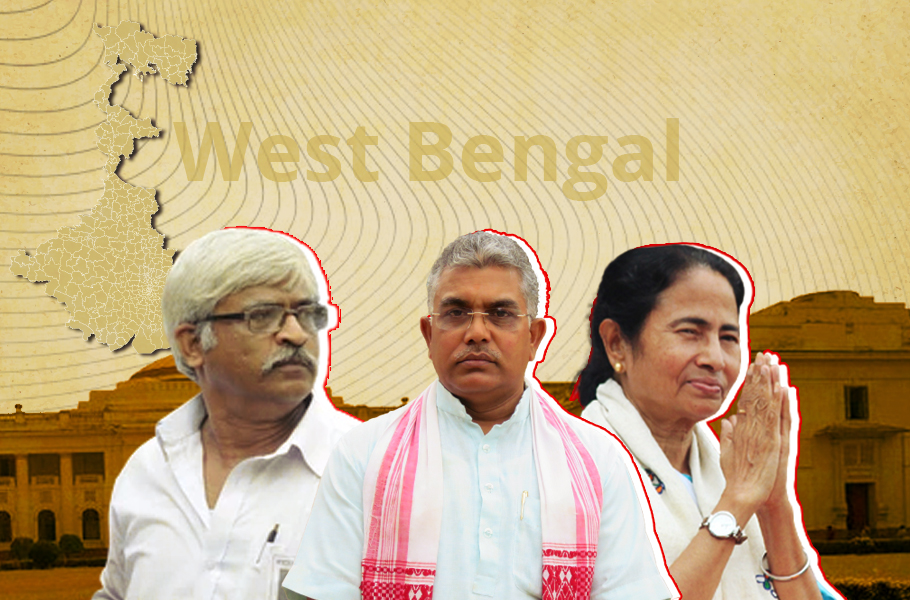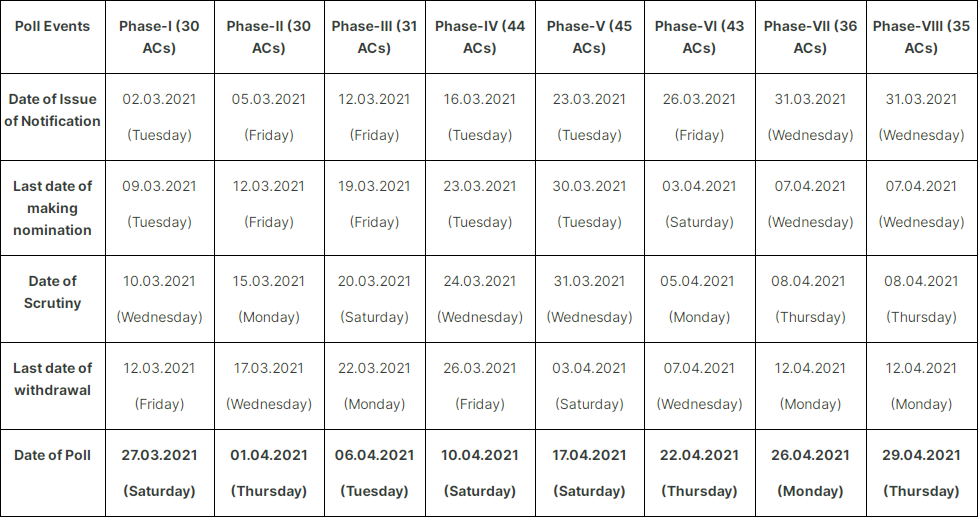
In 8-phase Bengal polls, Mamata's populism vs corruption charges
The election to the 294-seat West Bengal assembly will be held in eight phases beginning March 27 amid waves of shifting allegiances, new alliances, and fears of violence, with three major sides eyeing the Nabanna (Secretariat) citadel.

The election to the 294-seat West Bengal assembly will be held in eight phases beginning March 27 amid waves of shifting allegiances, new alliances, and fears of violence, with three major sides eyeing the Nabanna (Secretariat) citadel.
The Election Commission announced the schedule for the assembly elections in West Bengal, besides three other states – Assam, Tamil Nadu, and Kerala – and Puducherry, on Friday. Votes will be counted on May 2.
According to the schedule, Bengal is the only among five election-bound places to have an eight-phase election. The Commission cited several factors behind it, including movement of forces as the number of polling stations has gone up from 77,000 to 1.1 lakh this time. In 2016, the election was done in seven phases.
Election schedule:

Major contenders
The ruling Trinamool Congress, which had swept the 2016 elections with over a two-third majority in the assembly, will be facing a three-sided election this year, with the biggest competition expected from BJP, which had made major inroads into the state with 18 out of 40 seats in the 2019 Lok Sabha election.
On the third front is an alliance between Congress and Left parties, which have now tied up with Indian Secular Front (ISF) led by Pirzada Abbas Siddiqui, an influential Muslim cleric of the Furfura Sharif shrine in the state’s Hooghly district. ISF has negotiated 30 seats from the alliance. Further seat-sharing talks are on.
Election will be fought on…
The Mamata Banerjee-led Trinamool Congress (TMC) will be banking on its populist schemes to a large extent, besides its regionalism card, to beat the anti-incumbency factor and the saffron wave that had affected its 2019 Lok Sabha performance.
The party is widely advertising its “birth-to-death” welfare schemes, which include internationally-acclaimed Kanyashree, Sabooj Sathi, and Utkarsh Bangla, among others. Besides cash transfer schemes, it’s also banking on Swastha Sathi scheme that provides ₹5 lakh medical insurance coverage per annum per family.
Related news | BJP promises ‘Sonar Bangla’ by 2047, banks on ‘Modi magic’ for poll rallies
Moreover, Banerjee has recently announced continuation of free ration too. In the recent budget, she has also announced new subsidised canteens, replicating the popular Amma Canteens of Tamil Nadu which provide standard meals at cheaper rates.
The BJP, besides countering the ‘outsider’ tag used by TMC, is banking on Prime Prime Minister Narendra Modi’s image and Centre’s welfare schemes to win the state which has never had a saffron government. It has been attacking the TMC government for refusing the PM-Kisan scheme for farmers.
Development is also an important poll plank being used by the BJP this election, with top leaders making frequent visits to the state and holding massive rallies across the state. They have also been vocal against the “cut-money” culture and alleged corruption in Cycle Amphan relief distribution last year.
Related news | EC deploys massive security in Bengal even before poll announcement
The Left-Congress front, on the other hand, is fighting this year’s election over the government’s failure to boost industrialisation and employment generation in the state. Other issues like rising fuel and LPG prices too are also there, though they have been on the back seat thus far.
Previous elections
The TMC came to power in West Bengal in 2011 with Chief Minister Mamata Banerjee being credited for single-handedly ending the 33-year-old Left rule in the state. In the 2011 elections, her party won 184 seats, reducing arch-rival Left Front to 62. Congress had then won 42.
In the 2016 assembly election, TMC won another massive victory, bagging 211 seats across the state, reducing the Left further to the third spot, with 32 seats, behind the Congress’s 44. The BJP had won three seats in the election.
However, a saffron surge in recent years resulted in reducing TMC in the Lok Sabha election to 22 seats, with BJP winning an unprecedented 18 seats. TMC had won 34 out of 42 seats in the 2014 parliamentary polls. BJP had won two.

